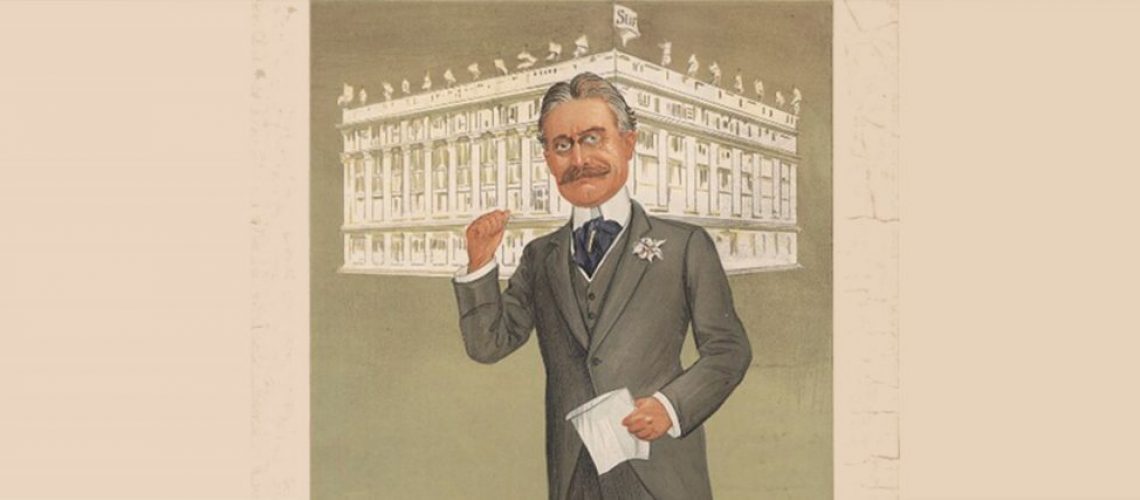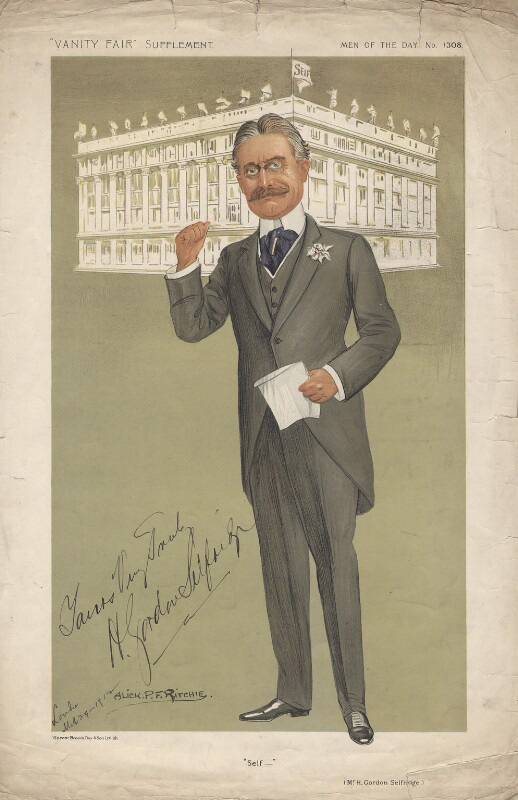…to enjoy the pleasures of shopping. When Harry Gordon Selfridge opened his splendid establishment in London, shopping became an entertainment as well as a necessity, as David Evans explains
On opening day, 15 March 1909, tens of thousands of potential customers crossed the doors of H Gordon Selfridge’s new palatial department store on Oxford Street and, by the end of the first week, this had increased to over one million.
Countless others flocked just to look at the store’s splendid windows, where elegant fashions were displayed against backgrounds evoking the work of 18th-century French painters Jean Honore Fragonard and Jean Antoine Watteau. Nine large lifts moved visitors speedily from level to level in the superbly lit store, where the sight and scent of freshly-created floral decorations, throughout, added to the resplendence of the establishment.
His ideas of roomy floor and window displays were a complete contrast with the often dowdy clutter found in London stores of the time and his replacement of somewhat haughty floorwalkers by trained sales staff and information desks meant that the common practice of removing customers who looked but did not buy was absent from his store. In fact, one of the advertisements announcing the opening of the store declared ‘we Wish it to be understood that our invitation is to the whole British public … and that the pleasures of shopping as well as those of sight-seeing begin from the opening hour’.
H Gordon Selfridge, a native of Wisconsin, USA, blew into London from the ‘Windy City’ of Chicago in 1906 determined to give Londoners the sort of shopping experience that those living in Chicago had when they visited Marshall Field, America’s leading department store, from which he had recently retired.
FW Woolworth, about to extend his mighty network of chain stores to Britain in 1909, was very impressed by Selfridge’s ‘American’ policy of encouraging potential customers to look around, but not necessarily buy – something relatively unknown in British department stores of the time and something customers would certainly practise in his own British shops.
During its 16th anniversary year, in 1925, Selfridge’s showed itself to be at the cutting edge of technology when John Logie Baird demonstrated his television set, or what he called a ‘televisor’, to those visiting the store.
Later, in its 30th anniversary year, in 1939, when the London-wide BBC Television Service had been established for 3 years, Selfridge’s opened its Television Department where some of the latest receivers, a few with screens as large as 14 inches, were displayed. Not content with this, the store set up a studio from which daily fashion shows were broadcast on around 50 television sets positioned throughout the building.
The outbreak of war saw the end of this and of H Gordon Selfridge’s connection with the store that bore his name. Over the course of the Second World War, Selfridge’s continued to serve its customers, often in the face of serious difficulties and restrictions. As early as November 1940, during the period of heavy bombing, it was writing, apologetically, to customers who complained about the late delivery of orders and, in June 1941, it set up an enquiry desk to help answer questions that customers had about clothes rationing and to help them obtain the best value from their allowance of around 60 clothing coupons per year.
By May 1943, the latter was proven by the fact that its men’s ready-to-wear lounge suits, at £13 5s 0d (£13.25), plus 26 coupons, were advertised as having pre-austerity features such as turn-ups and front pleats on the trousers – all banned on clothing manufactured since the introduction of clothes rationing. Fittingly(!), Selfridge’s customers were able to tear up their once-precious Clothing Books when the end of clothes rationing, on 15 March 1949, coincided with the store’s 40th anniversary.
In 1951, Selfridge’s was taken over by Lewis’s Department Stores of Liverpool and, in mid-1953, the facade of the building was decorated in appropriately patriotic fashion for the Queen’s coronation. By 1965, the Sears Group had taken control of the business. Today, it is owned by Galen Weston of Canada, re-establishing the original North American link forged by Harry Gordon Selfridge when his new department store on Oxford Street opened for business more than a century ago.


